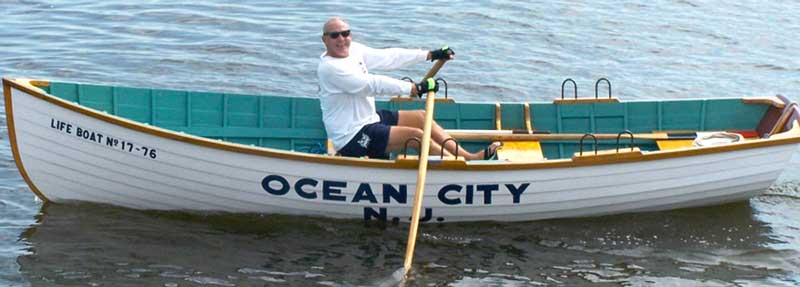Whenever I spot a lifeguard boat, it instantly takes me back to summertime in my youth at the Jersey Shore. Lifeguards and lifesaving boats are as much a part of the shore scene as the surf and sand and boardwalks.

17 76 was one of two lifesaving boats built for the 1976 Ocean City, NJ, Bicentennial event. She is one of the last two wooden models made by a boat builder that’s no longer in business. The other boat built for that bicentennial was named 18 76. Captain George T. Laferty, the head of Ocean City’s lifeguards and a former Navy Chief, named the boats on behalf of the city.
These boats are beach launched on rollers by two lifeguards. Up to three people can be rescued at a time with either one or two lifeguards manning the boat. Each boat has a line tied to it with a life ring attached at the opposite end of that line. When someone in the water needs to be rescued, a lifeguard throws that ring toward the person and then rows the boat around a second time in order to get the person and the life ring alongside the boat. At that point, the lifeguard is able to transfer the person from the life ring in the water to the boat.
She rows sweet, easy, and straight with her 54-inch beam and 17-foot length overall. Today’s lifeguard boats are made from fiberglass and are wider as well as heavier. As a result, the fiberglass boats require a lot more rowing energy to achieve the speed of the lighter wood boats.
17 76 is made of cedar planking with oak framing that is copper riveted. Built light compared to other wood boats for lifeguard duty and rescues, she’s also built to win races and has been fully restored. The restoration was done in 2006 with the help of the Philadelphia Wooden Boat Shop. During the restoration, one plank and all 17 frames were replaced. She was rechristened using a beach bucket of ocean saltwater and with now-retired Capt Laferty as the guest of honor.
She has had touch ups every few seasons since then. 17 76 is used for demonstration rowing by her owner and lead restorer. She has won Best of Show and Best of Class awards at boat shows. And she has been an invited guest boat at events stretching from Mystic, CT, to Atlantic City, NJ. She’s been displayed at the Atlantic City Power Boat Show, the Tuckerton Seaport Museum, and the Long Level Lake Antique and Classic Boat Society (ACBS) events. Last but not least, she also becomes a parade float at Christmastime. Being in a parade is a special joy.
Jack Brooks was a member of the Ocean City Lifeguard Service for 16 years and bought 17 76 in 2006 so he could restore her. Typically these boats have a 20-year service life.
Jack gets waves and thumbs up as he trailers this boat to shows and other events. It puts a smile on everyone’s face. It’s such an icon of the beloved Jersey Shore, even when the boat is inland from the beach and its native ocean waves. I can see I’m in good company among so many other people who have great memories of the Jersey shore from their youth, too.
Jack lives in Pennsylvania and at the New Jersey shore. Similar to the Sea Bright Skiff design used in 17 76, he has a sailing version of the 16-foot Sea Bright Skiff that is ready for restoration. Both the sailing and rowing versions of the Sea Bright Skiff are easy to beach launch, have a shallow draft, are stable in the surf, and date back to pre-1830.
Jack also has an ACBS Antique Class 1940 Pre-War Pendersen 34-foot sedan cruiser named Paper Moon that is very close to being done and going back in the water this summer. During the restoration a few more ribs were added so it could be moved by a Travelift. The many beams of a marine railway are actually better for the transfer of the boat than the two straps used by a Travelift because the railway transfers the boat’s weight more evenly. Unfortunately, though, marine railways are extremely rare.
By Chris "Seabuddy" Brown